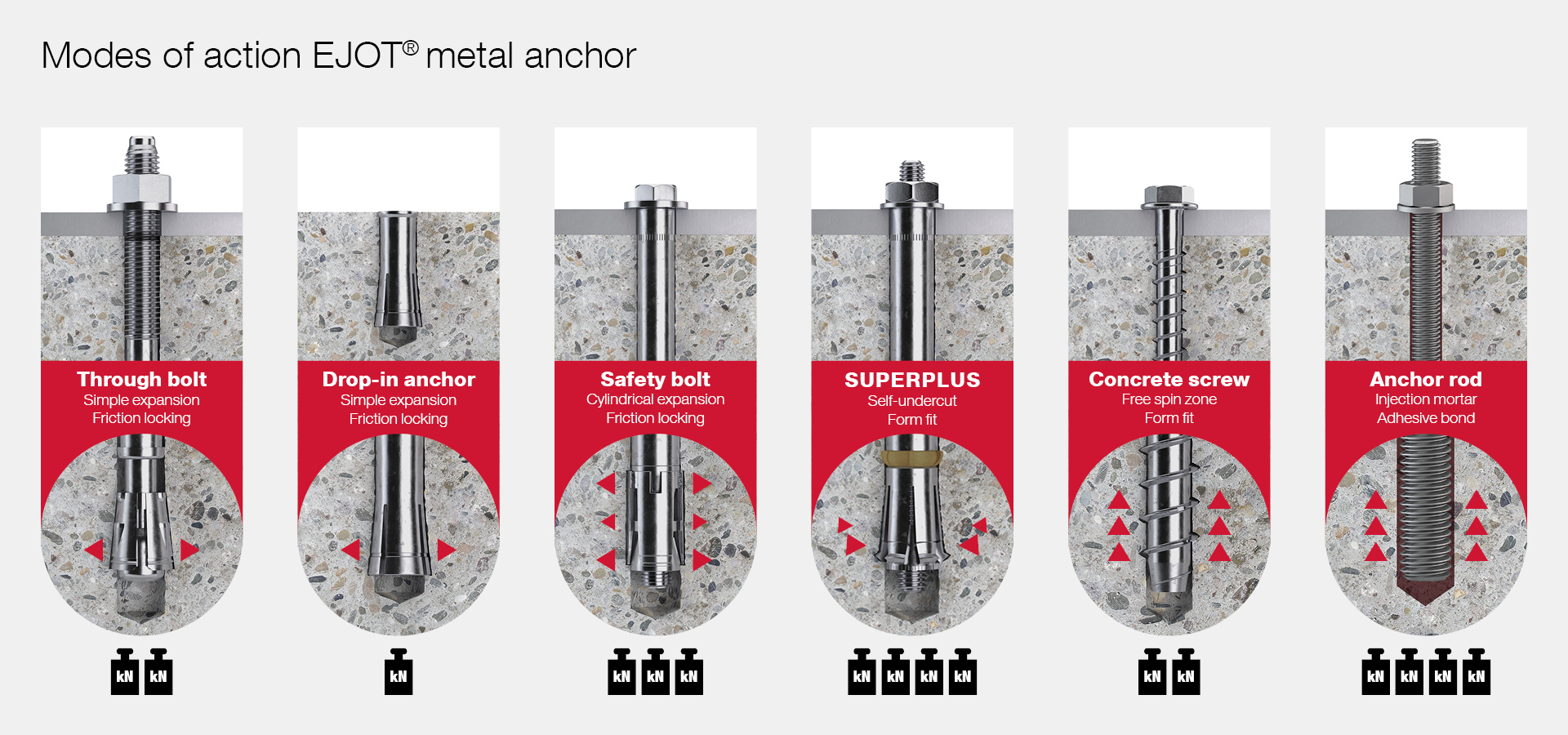Anchor function principles
Heavy-duty anchor Guidebook – Part 3
In the first articles of the heavy-duty anchor guide, we dealt with the type of base material and its requirements for fastening elements. The third part focuses on the anchoring methods. We shed light on the function principles and fastening elements and their advantages and disadvantages.
We generally differentiate between three physical function principles of anchoring: friction lock, form-fit and adhesive bond. Let's look at these anchoring methods in detail:
Advantages:
Note:
We generally differentiate between three physical function principles of anchoring: friction lock, form-fit and adhesive bond. Let's look at these anchoring methods in detail:
Friction lock
Expanding individual components within the borehole creates friction that securely fixes the anchor in the surface. We differentiate between torque-controlled and displacement-controlled expansion: The nut of the through bolt or the safety bolt must be tightened with a defined torque in order to fully expand the expansion sleeve. The metal cone must travel a certain distance inside the drop-in anchor in order to properly expand the sleeve in the borehole. The ETA-controlled setting tool ensures the correct distance.Advantages:
- Easy assembly (no setting tools, exception: drop-in anchors)
- Immediate load-carrying capacity (no curing times)
- Self-locking load bearing capacity: As soon as load is introduced via the add-on part, the cone bolt continues to pull into the sleeve. It continues to expand. (Exception drop-in anchor)
- Safety bolt with double cone for higher load bearing capacity
Note:
- Anchors with a large expansion require higher minimum centre and edge distances
- Expansion anchors are not removable
- Expansion anchors are only suitable for solid building materials (usually concrete) or, after a suitability test, for solid and natural stone
Form-fit
A form-fit is created by the gearing of the fastening element with the base material. Let us take a look at two types of anchors: The self-undercutting anchors such as the LIEBIG SUPERPLUS and the concrete screw JC2: The sharp edged segments of the LIEBIG SUPERPLUS sleeve cut deep into the concrete in the borehole. The thread flanks of the concrete screw create several form-fits during the screwing-in process. Therefore, they are called screw anchors. As with the expansion anchors, we differentiate between torque-controlled and displacement-controlled anchors.Advantages of self-undercutting anchors:
- High load-carrying capacities
- Ideal for absorbing extraordinary loads (e.g. earthquakes, impact loads)
- Low expansion forces (suitable for fastenings near the edge)
- Immediate load-carrying capacity (no curing times)
- Removable
- Independent undercut, no setting tools required
Note:
- Approved for concrete or after testing also suitable for solid and natural stone
- Higher price due to high load-carrying capacities
Advantages of concrete screws:
- Immediate load-carrying capacity (no curing times)
- Completely removable
- Cost-effective
- Low expansion forces (suitable for fastenings near the edge)
- Due to multiple interlocking in the surface, it is also suitable for perforated bricks with high gross density or prestressed concrete planks
Note:
- Upper limit in diameter
Adhesive bond
In the case of an adhesive bond, the components are connected to one another to form a generally insoluble unit. For an adhesive bond, the adhesive mortar connects the anchor to the surface. Let's take a look at the EJOT Multifix USF products with anchor rod and mesh sleeve as an example.Advantages:
- High load-carrying capacities
- No expansion forces (ideal for fastenings near the edge)
- Suitable for anchoring in solid and hollow building materials (hollow building materials require a mesh sleeve)
- Sealing function (e.g. use in white tubs)
Note:
- No immediate load-carrying capacity (curing times)
- Special assembly requirements:
- Thorough borehole cleaning (prevent high load-bearing capacity losses)
- Components must be mixed completely
- Processing and ambient temperatures affect the curing time
- Special storage requirements:
- Storage period
- Heat sensitivity

